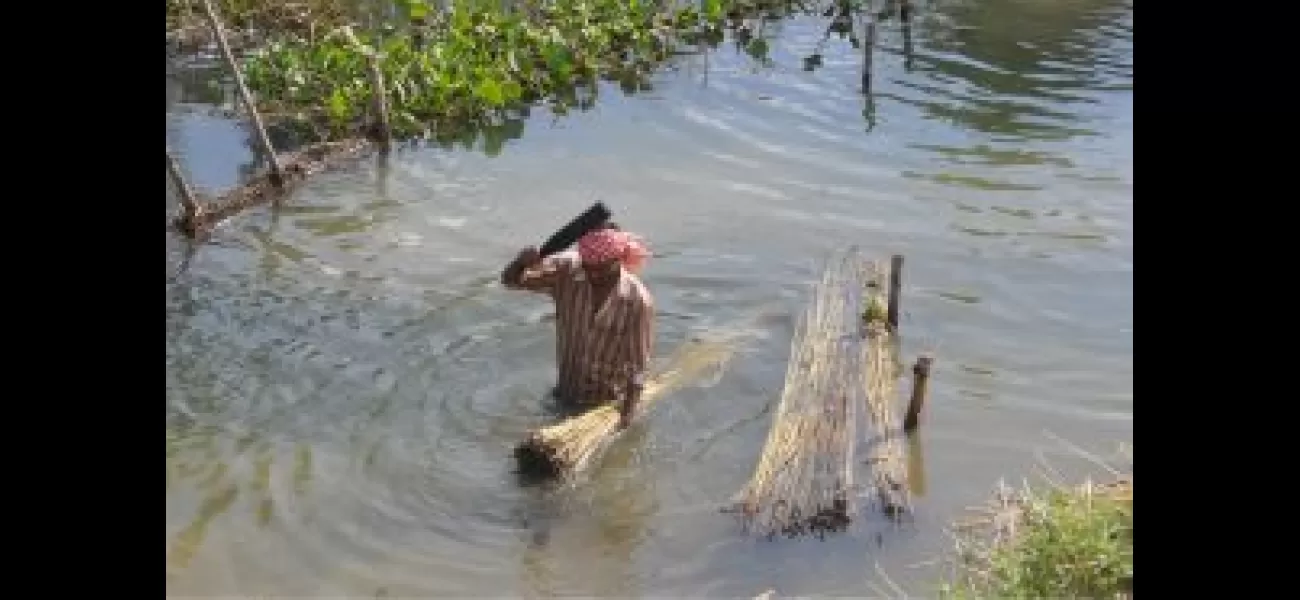Jute farming in Kendrapara faces challenges to survive.
Kendrapara district is known for growing fibre crops, but jute cultivation is declining due to neglect from the Agriculture Department.
June 19th 2024.

Kendrapara, a district in India, has long been known for its vibrant cultivation of fibre crops. Among these crops, jute has been a popular choice for farmers, alongside mesta and sesbania. In 2005, the farmers of Kendrapara were successfully growing these crops on 2,152 hectares of land. The favourable climatic conditions, suitable soil, and effective publicity campaigns played a crucial role in expanding this cultivation to 8,000 hectares by 2015. This impressive growth even led to the establishment of a jute research centre on 46 acres of land near the district headquarters town of Jajanga.
Unfortunately, this success story soon turned sour. In 2019-20, the research centre faced serious problems and was forced to stop selling seeds. As a result, the farmers were left with no choice but to buy seeds from the open market. However, to their dismay, the seeds turned out to be of sub-standard quality, causing major setbacks for their crops. Jute, a long, soft, and shiny bast fibre, is highly sought after for its strength and durability. It is also one of the most affordable natural fibres, second only to cotton in terms of production and versatility. The farmers of Kendrapara not only sell jute fibre but also utilize sweet jute leaves and Kaunria sticks in the local market. However, despite its importance, the cultivation of jute has been on the decline in Kendrapara due to a lack of support from the state government. This has led to a delay in the supply of jute, mesta, and sesbania seeds to the farmers.
Niranjan Parida, a farmer from Kansar panchayat, stated that the soil of Kendrapara is highly suitable for jute and mesta cultivation. Moreover, the cultivation of sesbania along with paddy crops has been found to improve soil nutrients and reduce pest attacks, as confirmed by farmer leader Gayadhar Dhal. However, the farming season in Kendrapara traditionally begins on Akshaya Tritiya, but the failure of the Agriculture Department to supply the necessary seeds at the start of the festival has been a major setback for the farmers.
Maheswar Sethi, a farmer from Chatarachakada village, shared that the price of jute seeds has increased from Rs 40 per kg in 2015 to Rs 90 per kg in the open market. This has been a major blow to jute farmers, who are struggling to keep up with the rising costs. Ramamani Samal, a member of a women's self-help group in Paripangara village, highlighted the government's ban on single-use plastic, which has presented a unique opportunity for jute-based cottage industries. However, the decline in domestic jute production has resulted in a higher cost of raw materials, affecting their profit margins. She emphasized the need for promoting jute cultivation in the district with government support.
Banamabar Sahu, a senior citizen, pointed out that agriculture is the main source of livelihood for the people of Kendrapara, as the district lacks major industries. However, due to a lack of support from the state government, farmers are losing interest in jute cultivation. When approached for comments, the district agriculture officer, Manoj Chand, stated that the Odisha Seeds Supply Corporation had successfully supplied jute, mesta, and sesbania seeds in 2015. However, the OSSC has now stopped procuring jute and mesta seeds, causing a major setback for the farmers who require 30 quintals of seeds every year. This year, they have only received 120 quintals of sesbania seeds.
In conclusion, the decline of jute cultivation in Kendrapara is a cause for concern, requiring immediate intervention from the state government. The farmers, who have long relied on jute as a source of income, are now struggling due to a lack of support and sponsorship. It is time for the government to step in and promote the cultivation of jute, mesta, and sesbania in Kendrapara, ensuring a stable livelihood for its people.
Unfortunately, this success story soon turned sour. In 2019-20, the research centre faced serious problems and was forced to stop selling seeds. As a result, the farmers were left with no choice but to buy seeds from the open market. However, to their dismay, the seeds turned out to be of sub-standard quality, causing major setbacks for their crops. Jute, a long, soft, and shiny bast fibre, is highly sought after for its strength and durability. It is also one of the most affordable natural fibres, second only to cotton in terms of production and versatility. The farmers of Kendrapara not only sell jute fibre but also utilize sweet jute leaves and Kaunria sticks in the local market. However, despite its importance, the cultivation of jute has been on the decline in Kendrapara due to a lack of support from the state government. This has led to a delay in the supply of jute, mesta, and sesbania seeds to the farmers.
Niranjan Parida, a farmer from Kansar panchayat, stated that the soil of Kendrapara is highly suitable for jute and mesta cultivation. Moreover, the cultivation of sesbania along with paddy crops has been found to improve soil nutrients and reduce pest attacks, as confirmed by farmer leader Gayadhar Dhal. However, the farming season in Kendrapara traditionally begins on Akshaya Tritiya, but the failure of the Agriculture Department to supply the necessary seeds at the start of the festival has been a major setback for the farmers.
Maheswar Sethi, a farmer from Chatarachakada village, shared that the price of jute seeds has increased from Rs 40 per kg in 2015 to Rs 90 per kg in the open market. This has been a major blow to jute farmers, who are struggling to keep up with the rising costs. Ramamani Samal, a member of a women's self-help group in Paripangara village, highlighted the government's ban on single-use plastic, which has presented a unique opportunity for jute-based cottage industries. However, the decline in domestic jute production has resulted in a higher cost of raw materials, affecting their profit margins. She emphasized the need for promoting jute cultivation in the district with government support.
Banamabar Sahu, a senior citizen, pointed out that agriculture is the main source of livelihood for the people of Kendrapara, as the district lacks major industries. However, due to a lack of support from the state government, farmers are losing interest in jute cultivation. When approached for comments, the district agriculture officer, Manoj Chand, stated that the Odisha Seeds Supply Corporation had successfully supplied jute, mesta, and sesbania seeds in 2015. However, the OSSC has now stopped procuring jute and mesta seeds, causing a major setback for the farmers who require 30 quintals of seeds every year. This year, they have only received 120 quintals of sesbania seeds.
In conclusion, the decline of jute cultivation in Kendrapara is a cause for concern, requiring immediate intervention from the state government. The farmers, who have long relied on jute as a source of income, are now struggling due to a lack of support and sponsorship. It is time for the government to step in and promote the cultivation of jute, mesta, and sesbania in Kendrapara, ensuring a stable livelihood for its people.
[This article has been trending online recently and has been generated with AI. Your feed is customized.]
[Generative AI is experimental.]
0
0
Submit Comment





